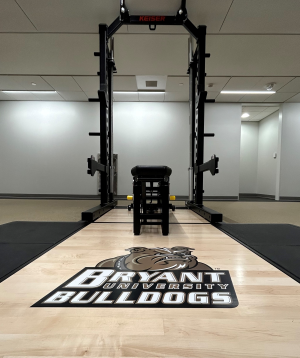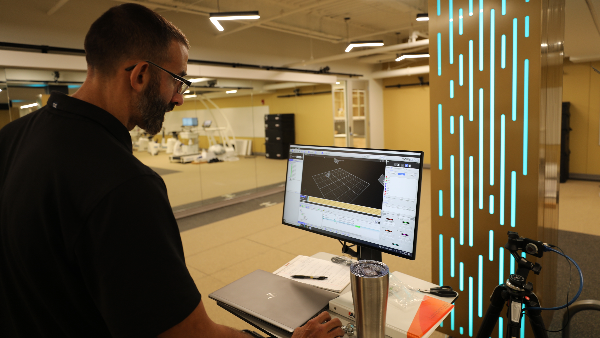For those looking to work in the health and fitness realm, Bryant University’s new Exercise and Movement Science lab, on the lower level of the Unistructure, is a slice of paradise. A spacious facility packed with the field’s most innovative technologies, the lab opens this semester with an abundance of experiential learning opportunities for students in collaboration with expert faculty.
“Students are getting access to the best equipment in the exercise science field,” says Exercise and Movement Science Program Director Jason Sawyer, Ph.D. “They will graduate with skills that are beyond what a normal exercise science undergraduate comes out with.”
The School of Health and Behavioral Sciences’ Exercise and Movement Science program recently welcomed its inaugural cohort of 20 students to campus; these individuals will spend the next four years preparing to work in a range of fitness and athletic careers, such as personal training, exercise physiology, and physical therapy. Students will have at least one course per year in the new lab, including “Exercise Testing and Prescription,” “Human Kinesiology,” and “Principles of Strength and Conditioning.”
“They’re going to get hands-on experience using this state-of-the-art equipment, which is very exciting,” Sawyer says, adding that Bryant’s small class sizes allow for more personal connections between faculty and students and more time with new professional-level tools.
An innovative, hands-on lab

is packed with the field’s most innovative technologies.
When students enter the Exercise and Movement Science lab, they are met with a collaboration space to the right and a conference room to the left. Just beyond the collaboration space, students find strength training machines which, Sawyer notes, use air pressure instead of traditional weights. Over the course of their time at Bryant, students will learn to calibrate the equipment, run the machines, and troubleshoot issues.
Across the lab, the far corner includes a body composition area where the main attraction is a sleek, egg-shaped device known as a BOD POD. While seated inside the machine, a person’s body composition is determined using air pressure technology.
Sawyer notes that the lab also has a bioelectrical impedance analysis scale that sends a low voltage electrical current to the body and determines body composition to a high level of accuracy.
“This scale is unique, because it can also examine segments — meaning the machine can measure one arm and determine how much fat and fat-free mass it has,” Sawyer says.
Additionally, the space includes cardiac rehabilitation bikes used in hospital settings and high-end treadmills with harness systems. Sawyer says the harnesses protect users from trips and falls, as the machine picks up the person slightly and dangles them to reduce the risk of injury. Metabolic carts accompany the treadmills. Sawyer says if students wear one of the cart’s masks, they can capture respiratory gases and analyze the amount of carbon dioxide produced and oxygen consumed while on the treadmill.
Advanced technology
The lab also contains a motion capture system where reflectors are placed on different body parts and 10 infrared cameras capture a person moving in a specific area within the lab; instant feedback is then digitally documented.
“You can calculate the forces of all the joints, look at movement anomalies, changes in gait with aging, or measure and quantify elements with the force plate,” Sawyer says, adding that force plates underneath the floor measure step pressure.

He says this technology is especially valuable to students who want to be biomechanists or go into equipment design. For instance, a graduate could apply this technology to determine the appropriate length of a bat or how far away the ball’s point of force application should be from a player’s rotating joint.
The lab also has two portable metabolic systems that an individual could carry like a backpack and walk around in while wearing a mask.
“You could tell somebody to go on a hike and come back an hour later. We could then record all their data measured on that hike and analyze it using the metabolic systems,” Sawyer says, emphasizing how students can bring the real-time data to the classroom for further study.
Campus collaboration
This fall, Sawyer hopes to recruit several interns who will learn to use the lab equipment and measure physiological variables. He adds that biology and physics labs will also take advantage of the space, and the program will work with the university’s Athletics Department on monitoring athletes throughout the season, and again postseason, to test how the rigors of Division 1 athletics affect their bodies.
As for student research opportunities, Sawyer’s answer is simple: “If you want to test it, we can measure it in this lab.”
Click here to learn more about Bryant’s Exercise and Movement Science program.

:max_bytes(150000):strip_icc()/GettyImages-1144769011-28ed184dd64e4f56813b91f6c6ca5eef.jpg)
